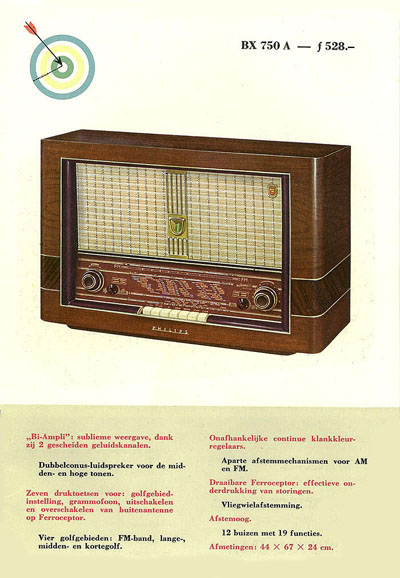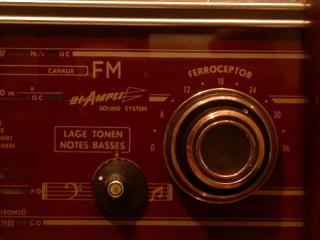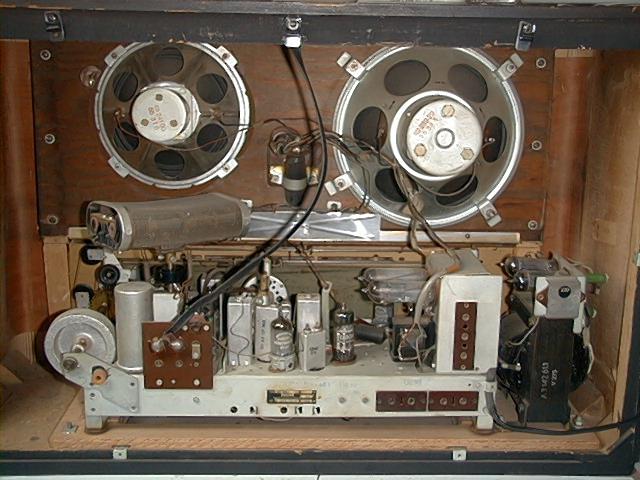Price was 528 guilders, see 1956 folder:
 .
.
184
Item nr.

Luxe set for demanding people
| Production | The Netherlands, 1955.
Price was 528 guilders, see 1956 folder:  . . |
|---|---|
| Bands | LW (870-2000m), MW (186-580m), SW 16.7-50.5m), FM (3.0-3.4m). |
| Tubes | EF80 (FM preamp), EC92 (FM converter), EF85 (IF for FM), ECH81 (AM converter), EF41 (IF amp), EABC80 (detector), ECC83 (AF preamp), EL84 (treble output), EL84 (bass output), 2xEZ80 (rectifiers), EM80 (indicator). |
| Cabinet | Wood. Size 67x43.5x24.3 cm. |
| Power | AC 110, 127, 145, 200, 220, 245V at 100W. |
| Documents | Service documentation. |
 By 1955 the FM technology had matured and Bi-Ampli had been introduced to further perfect sound quality. True Bi-Ampli means that treble and bass signals are split before the output amplifier, and have separate output amplification. The BX998A has a single-ended push-pull for the basses, but this quote-cheapo-unquote has to do with a single EL84 for the basses. Needless to say there are two loudspeakers, a 9768M for treble and a 9710-00 for basses. To give you an impression of the effect: without the bass working, the radio sounds very much like an average good radio. (Later the term Bi-Ampli was used more as a marketing ploy for radios with just a single output stage.)
By 1955 the FM technology had matured and Bi-Ampli had been introduced to further perfect sound quality. True Bi-Ampli means that treble and bass signals are split before the output amplifier, and have separate output amplification. The BX998A has a single-ended push-pull for the basses, but this quote-cheapo-unquote has to do with a single EL84 for the basses. Needless to say there are two loudspeakers, a 9768M for treble and a 9710-00 for basses. To give you an impression of the effect: without the bass working, the radio sounds very much like an average good radio. (Later the term Bi-Ampli was used more as a marketing ploy for radios with just a single output stage.) In the extreme left on this inside picture you can see the flywheel for tuning. A clutch mechanism connects the tuning knob and flywheel to either the FM or the AM tuning capacitor. The FM tuner of the radio has EF80/EC92 and is integrated with the rest of the chassis (while later sets had an ECC85 tuner in a separate box). For MW/LW there are built-in ferrite rods, which can be rotated from the front. They are enclosed in an electric shielding to optimize the directional effect and eliminate electrostatic noise. For FM a dipole is built-in, but of course a better reception is possible with a roof aerial. The radio has provisions to use the FM antenna as a wire antenna for AM, and other mixed uses.
In the extreme left on this inside picture you can see the flywheel for tuning. A clutch mechanism connects the tuning knob and flywheel to either the FM or the AM tuning capacitor. The FM tuner of the radio has EF80/EC92 and is integrated with the rest of the chassis (while later sets had an ECC85 tuner in a separate box). For MW/LW there are built-in ferrite rods, which can be rotated from the front. They are enclosed in an electric shielding to optimize the directional effect and eliminate electrostatic noise. For FM a dipole is built-in, but of course a better reception is possible with a roof aerial. The radio has provisions to use the FM antenna as a wire antenna for AM, and other mixed uses.
The IF bandwidth is influenced by the treble control, notice the small bowden cable running to the IF transformer in the middle behind the Rimlock tube. Further to the right you can see the two EL84 tubes in horizontal position on a box containing the output amplifier with the trebles output transformer below it. The bass output transformer is under the chassis.
The 100W power transformer (with multiple primary taps like most European radios have) with two rectifier tubes on top of it is located next to the chassis.
| Obtained | 7/2001 from Bert Brummel. |
|---|---|
| Condition | 9. |
| Disposed | Sold 8/2006. |
| Sound sample | PLAY SOUND The radio show Arbeidsvitaminen (labor vitamins) first aired in 1946 and has been on the Dutch radio continually since then. It was officially declared to be the longest running radio show in the world on May 1, 2006. This event was celebrated on the radio as De dag van de Arbeidsvitaminen (Labor Vitamin Day). |
 Brummel could buy in the Philips staff shop. There you can buy Philips products at lower prices than in ordinary shops, and moreover there are sometimes extra possibilities like buying from your gross salary instead of from your net salary so you profit from a tax reduction over the amount. So with all these advantages added on top of each other, Mr Brummel could afford this master piece. Nobody else of the family was allowed to touch it! This was very much to the dislike of little Bert, who often drooled around the radio wanting to play with the flywheel tuning, feeling a strong desire to overhear exotic countries on short wave and excellent music on FM. Bert later became an enthousiastic SW DX-er, but on other radios. When he grew big, his father passed away and the radio landed in Bert's attic: unused now because it was about 25 years old and technically obsolete. After the radio had eaten dust for another 20 years, the attic had to be cleared out, and what to do with this old family piece? Bert found Gerard's Radio Corner on the Internet and decided to donate it the radio.
Brummel could buy in the Philips staff shop. There you can buy Philips products at lower prices than in ordinary shops, and moreover there are sometimes extra possibilities like buying from your gross salary instead of from your net salary so you profit from a tax reduction over the amount. So with all these advantages added on top of each other, Mr Brummel could afford this master piece. Nobody else of the family was allowed to touch it! This was very much to the dislike of little Bert, who often drooled around the radio wanting to play with the flywheel tuning, feeling a strong desire to overhear exotic countries on short wave and excellent music on FM. Bert later became an enthousiastic SW DX-er, but on other radios. When he grew big, his father passed away and the radio landed in Bert's attic: unused now because it was about 25 years old and technically obsolete. After the radio had eaten dust for another 20 years, the attic had to be cleared out, and what to do with this old family piece? Bert found Gerard's Radio Corner on the Internet and decided to donate it the radio. The photo on the left shows that it was a bit dusty on the inside, but the radio still played. Normally I do not care very much about tuning eyes, because tuning by ear is often more precise than tuning by eye. However, with FM it is different; so among the six tubes I replaced was the EM80 indicator, and I replaced the controlling resistor as well. The eye now reacts well and shines brightly.
The photo on the left shows that it was a bit dusty on the inside, but the radio still played. Normally I do not care very much about tuning eyes, because tuning by ear is often more precise than tuning by eye. However, with FM it is different; so among the six tubes I replaced was the EM80 indicator, and I replaced the controlling resistor as well. The eye now reacts well and shines brightly.

 The radio plays fairly well (as you can hear in the sound demo), works on all bands, and is in very presentable cosmetic condition. On the top edge, above the treble speaker, there is a dent in the wood, and I think somebody dropped something on the radio at some moment during the last five decades. On the left cheek of the radio (the side where the volume control is) there is a strange decoloration on the wood. It looks as if there is some metallic paint under the lacquor. Because I don't think the lacquor was a redo, I must conjecture that this happened in the factory. Is it possible that radios with cosmetic faults were sold in the staff shop, at further reduced prices perhaps?
The radio plays fairly well (as you can hear in the sound demo), works on all bands, and is in very presentable cosmetic condition. On the top edge, above the treble speaker, there is a dent in the wood, and I think somebody dropped something on the radio at some moment during the last five decades. On the left cheek of the radio (the side where the volume control is) there is a strange decoloration on the wood. It looks as if there is some metallic paint under the lacquor. Because I don't think the lacquor was a redo, I must conjecture that this happened in the factory. Is it possible that radios with cosmetic faults were sold in the staff shop, at further reduced prices perhaps?